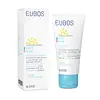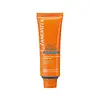What's inside
What's inside
 Key Ingredients
Key Ingredients

 Benefits
Benefits

 Concerns
Concerns

No concerns
 Ingredients Side-by-side
Ingredients Side-by-side

Water
Skin ConditioningDibutyl Adipate
EmollientC12-15 Alkyl Benzoate
AntimicrobialGlycerin
HumectantDiethylamino Hydroxybenzoyl Hexyl Benzoate
UV FilterEthylhexyl Triazone
UV AbsorberArginine
MaskingPhenylbenzimidazole Sulfonic Acid
UV AbsorberDicaprylyl Carbonate
EmollientBis-Ethylhexyloxyphenol Methoxyphenyl Triazine
Skin ConditioningGlyceryl Undecylenate
EmollientPanthenol
Skin ConditioningTocopheryl Acetate
AntioxidantHydroxyacetophenone
AntioxidantAcrylates/C10-30 Alkyl Acrylate Crosspolymer
Emulsion StabilisingCarbomer
Emulsion StabilisingXanthan Gum
EmulsifyingUbiquinone
AntioxidantCitric Acid
BufferingWater, Dibutyl Adipate, C12-15 Alkyl Benzoate, Glycerin, Diethylamino Hydroxybenzoyl Hexyl Benzoate, Ethylhexyl Triazone, Arginine, Phenylbenzimidazole Sulfonic Acid, Dicaprylyl Carbonate, Bis-Ethylhexyloxyphenol Methoxyphenyl Triazine, Glyceryl Undecylenate, Panthenol, Tocopheryl Acetate, Hydroxyacetophenone, Acrylates/C10-30 Alkyl Acrylate Crosspolymer, Carbomer, Xanthan Gum, Ubiquinone, Citric Acid
Water
Skin ConditioningOctocrylene
UV AbsorberTribehenin PEG-20 Esters
EmollientGlycerin
HumectantDiisopropyl Sebacate
EmollientHomosalate
Skin ConditioningButyl Methoxydibenzoylmethane
UV AbsorberPhenylbenzimidazole Sulfonic Acid
UV AbsorberC12-15 Alkyl Benzoate
AntimicrobialCyclopentasiloxane
EmollientAlcohol
AntimicrobialEthylhexyl Methoxycinnamate
UV AbsorberMethylene Bis-Benzotriazolyl Tetramethylbutylphenol
UV FilterPolymethylsilsesquioxane
Bis-Ethylhexyloxyphenol Methoxyphenyl Triazine
Skin ConditioningAlpha-Isomethyl Ionone
PerfumingAluminum Hydroxide
EmollientAluminum Stearate
Cosmetic ColorantAngelica Archangelica Root Extract
MaskingAscorbic Acid
AntioxidantAscorbyl Palmitate
AntioxidantBenzyl Alcohol
PerfumingBenzyl Benzoate
AntimicrobialBenzyl Salicylate
PerfumingBHT
AntioxidantButylphenyl Methylpropional
PerfumingCaffeine
Skin ConditioningCalcium Sodium Phosphosilicate
Camellia Sinensis Leaf Extract
AntimicrobialCaprylyl Glycol
EmollientCinnamal
PerfumingCitric Acid
BufferingCitronellol
PerfumingCitrus Aurantium Amara Peel Extract
MaskingCoffea Arabica Seed Extract
MaskingCyclohexasiloxane
EmollientDecyl Glucoside
CleansingDimethylmethoxy Chromanol
AntioxidantDisodium EDTA
Farnesol
PerfumingGeraniol
PerfumingGlycine
BufferingHippophae Rhamnoides Oil
EmollientHydrolyzed Citrus Aurantium Dulcis Fruit Extract
Skin ProtectingHydroxycitronellal
PerfumingHydroxyethyl Acrylate/Sodium Acryloyldimethyl Taurate Copolymer
Emulsion StabilisingLecithin
EmollientLimonene
PerfumingLinalool
PerfumingMagnesium Aluminum Silicate
AbsorbentMaltodextrin
AbsorbentMauritia Flexuosa Fruit Oil
Skin ConditioningMica
Cosmetic ColorantPEG-8
HumectantPolysorbate 60
EmulsifyingPongamia Pinnata Seed Extract
Skin ConditioningPropylene Glycol
HumectantRuby Powder
Skin ConditioningSclerotium Gum
Emulsion StabilisingSodium Hydroxide
BufferingSodium Lactate Methylsilanol
Skin ConditioningSorbitan Isostearate
EmulsifyingSynthetic Fluorphlogopite
Tin Oxide
AbrasiveTitanium Dioxide
Cosmetic ColorantTocopherol
AntioxidantXanthan Gum
EmulsifyingChlorphenesin
AntimicrobialPhenoxyethanol
PreservativeSalicylic Acid
MaskingSorbic Acid
PreservativeParfum
MaskingCI 14700
Cosmetic ColorantCI 19140
Cosmetic ColorantCI 77891
Cosmetic ColorantWater, Octocrylene, Tribehenin PEG-20 Esters, Glycerin, Diisopropyl Sebacate, Homosalate, Butyl Methoxydibenzoylmethane, Phenylbenzimidazole Sulfonic Acid, C12-15 Alkyl Benzoate, Cyclopentasiloxane, Alcohol, Ethylhexyl Methoxycinnamate, Methylene Bis-Benzotriazolyl Tetramethylbutylphenol, Polymethylsilsesquioxane, Bis-Ethylhexyloxyphenol Methoxyphenyl Triazine, Alpha-Isomethyl Ionone, Aluminum Hydroxide, Aluminum Stearate, Angelica Archangelica Root Extract, Ascorbic Acid, Ascorbyl Palmitate, Benzyl Alcohol, Benzyl Benzoate, Benzyl Salicylate, BHT, Butylphenyl Methylpropional, Caffeine, Calcium Sodium Phosphosilicate, Camellia Sinensis Leaf Extract, Caprylyl Glycol, Cinnamal, Citric Acid, Citronellol, Citrus Aurantium Amara Peel Extract, Coffea Arabica Seed Extract, Cyclohexasiloxane, Decyl Glucoside, Dimethylmethoxy Chromanol, Disodium EDTA, Farnesol, Geraniol, Glycine, Hippophae Rhamnoides Oil, Hydrolyzed Citrus Aurantium Dulcis Fruit Extract, Hydroxycitronellal, Hydroxyethyl Acrylate/Sodium Acryloyldimethyl Taurate Copolymer, Lecithin, Limonene, Linalool, Magnesium Aluminum Silicate, Maltodextrin, Mauritia Flexuosa Fruit Oil, Mica, PEG-8, Polysorbate 60, Pongamia Pinnata Seed Extract, Propylene Glycol, Ruby Powder, Sclerotium Gum, Sodium Hydroxide, Sodium Lactate Methylsilanol, Sorbitan Isostearate, Synthetic Fluorphlogopite, Tin Oxide, Titanium Dioxide, Tocopherol, Xanthan Gum, Chlorphenesin, Phenoxyethanol, Salicylic Acid, Sorbic Acid, Parfum, CI 14700, CI 19140, CI 77891
Ingredients Explained
These ingredients are found in both products.
Ingredients higher up in an ingredient list are typically present in a larger amount.
You might know this ingredient as Tinosorb S or Bemotrizinol. It is a UV filter that covers both UVA and UVB rays.
This ingredient has two peak UV absorption peaks ( 310 and 340 nm) and is able to absorb both UV-A and UV-B rays. This ingredient works by preventing UV rays from reaching and damaging your skin.
On top of that - it is highly photostable and helps prevent the photodegration of other sunscreen ingredients such as avobenzone.
Tinosorb S is allowed in the EU, Australia, and Asia. It is close to being approved by the FDA and we'll hopefully get this ingredient in the U.S. by late 2025.
Fun fact: Tinosorb S is the most effective UV absorber at maximum concentration (measured by SPF) permitted in the EU.
This ingredient is oil-soluble, so your oil-cleansers will take this right off at night.
Learn more about Bis-Ethylhexyloxyphenol Methoxyphenyl TriazineC12-15 Alkyl Benzoate is made up of Benzoic Acid and long chain alcohols. It has a low molecular weight.
C12-15 Alkyl Benzoate is an emollient and texture enhancer. Due to its solubility, it is often used in sunscreens to help evenly distribute active ingredients.
As an emollient, C12-15 Alkyl Benzoate helps soften and hydrate your skin. Emollients create a film on your skin that traps moisture within.
This ingredient has been reported to cause eye irritation.
Learn more about C12-15 Alkyl BenzoateCitric Acid is an alpha hydroxy acid (AHA) naturally found in citrus fruits like oranges, lemons, and limes.
Like other AHAs, citric acid can exfoliate skin by breaking down the bonds that hold dead skin cells together. This helps reveal smoother and brighter skin underneath.
However, this exfoliating effect only happens at high concentrations (20%) which can be hard to find in cosmetic products.
Due to this, citric acid is usually included in small amounts as a pH adjuster. This helps keep products slightly more acidic and compatible with skin's natural pH.
In skincare formulas, citric acid can:
While it can provide some skin benefits, research shows lactic acid and glycolic acid are generally more effective and less irritating exfoliants.
Most citric acid used in skincare today is made by fermenting sugars (usually from molasses). This synthetic version is identical to the natural citrus form but easier to stabilize and use in formulations.
Read more about some other popular AHA's here:
Learn more about Citric AcidGlycerin is already naturally found in your skin. It helps moisturize and protect your skin.
A study from 2016 found glycerin to be more effective as a humectant than AHAs and hyaluronic acid.
As a humectant, it helps the skin stay hydrated by pulling moisture to your skin. The low molecular weight of glycerin allows it to pull moisture into the deeper layers of your skin.
Hydrated skin improves your skin barrier; Your skin barrier helps protect against irritants and bacteria.
Glycerin has also been found to have antimicrobial and antiviral properties. Due to these properties, glycerin is often used in wound and burn treatments.
In cosmetics, glycerin is usually derived from plants such as soybean or palm. However, it can also be sourced from animals, such as tallow or animal fat.
This ingredient is organic, colorless, odorless, and non-toxic.
Glycerin is the name for this ingredient in American English. British English uses Glycerol/Glycerine.
Learn more about GlycerinThis ingredient is more commonly known as Ensulizole, a chemical sunscreen ingredient.
Ensulizole mainly protects UV-B (290-340 nm) but offers a little UV-A (320-400 nm) protection. It is often paired with less photo-stable sunscreen ingredients due to its photo-stability.
Due to it being water-soluble, Ensulizole helps give sunscreens a light and non-oily texture.
Ensulizole is approved worldwide:
Learn more about Phenylbenzimidazole Sulfonic AcidWater. It's the most common cosmetic ingredient of all. You'll usually see it at the top of ingredient lists, meaning that it makes up the largest part of the product.
So why is it so popular? Water most often acts as a solvent - this means that it helps dissolve other ingredients into the formulation.
You'll also recognize water as that liquid we all need to stay alive. If you see this, drink a glass of water. Stay hydrated!
Learn more about WaterXanthan gum is used as a stabilizer and thickener within cosmetic products. It helps give products a sticky, thick feeling - preventing them from being too runny.
On the technical side of things, xanthan gum is a polysaccharide - a combination consisting of multiple sugar molecules bonded together.
Xanthan gum is a pretty common and great ingredient. It is a natural, non-toxic, non-irritating ingredient that is also commonly used in food products.
Learn more about Xanthan Gum